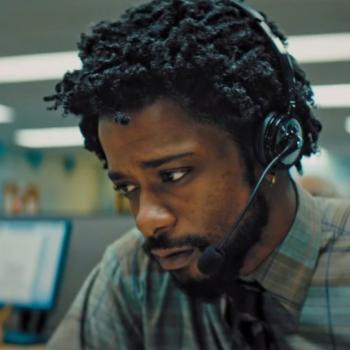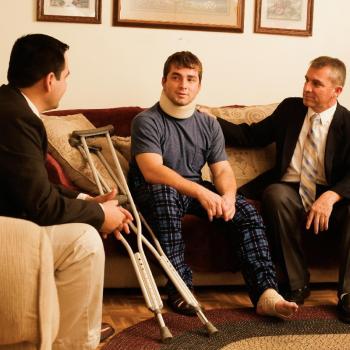This is part 3 of a 3-part discussion with Alex Griffin and Eve Tushnet. In the first post, Alex and Eve discussed discourse on homosexuality in Mormonism and Catholicism. In the second post, they discuss what elements of their faiths and other faiths they have found useful in interpreting their sexual orientation. In this post, they turn their questions toward each other.
What have you found interesting about each others’ answers? What was unexpected, enlightening? How might you try to apply things you have learned in your life and/or faith community?
EVE: I really want to hear more about the extended family and ritual adoption in Mormonism! Is there a movement to bring back ritual adoption? What obstacles might that face, what new problems might arise, how is Mormon ritual adoption different from adelphopoeisis and/or different from what an outsider might expect? Tell me more!
MICHAEL: My read on the so-called “Law of Adoption” is that it was a way of sealing unattached men to men; when there were women who found themselves outside of sealed relationships, they were taken on by men as wives under polygamy. [fn1] Since the husband-wife sealing was conceived as essentially reproductive, the way to get same-sex sealings (once again, exclusively male) was to assign parental and filial roles to the participants. Some adoptees even tacked their adoptive fathers’ surnames onto their own, most notably John D. Lee, who for a time after his adoption by Brigham Young signed his name “John D. Lee Young.”
As far as I know, there’s little to no movement to bring back ritual adoption–and for many reasons, not least the fact that almost no one knows about it. In the past, some few have apparently used the Law of Adoption as a justification for homosexual sealings. Today, various scholars have been exploring the role so-called “adoption theology”–but not a revival of ritual adoption as practiced in the 1800s–could play in LDS practices and teachings. One scholar, Taylor Petrey, proposed that replacing models of family based on heterosexual reproduction with models based on adoption could be a way to justify homosexual sealings in Mormonism. Needless to say, his paper was–and is still–quite controversial!
From my brief Wikipedia skim on adelphopoiesis (which, curiously, includes a link to the LDS Law of Adoption!), it seems that the biggest difference with Mormon adoptive sealings is that the latter were always explicitly hierarchical: father- and son-making, not brother-making.
EVE: I’d also be really interested in hearing specific stories of extended-family life for queer people in the LDS Church. Actually I feel like for every sentence Alex wrote there are probably several fascinating stories, so if she’d be willing to write more on what things look like in practice, I’d love to hear it. Also interested in more on how the situation of queer people differs from that of straight singles, and, ideally, stories of forging solidarity which respects difference rather than ignoring it.
ALEX: As far as extended family stuff, I’m lucky: mine is extremely supportive. Even those who I think are kind of uncomfortable, or don’t always understand, or worry about accidentally offending me keep in contact, show up to things to support me, and so forth. I think there is an ongoing shift for a lot of Mormons in deciding that dedication to family ties takes precedence, and hopefully a broader cultural move away from horror stories about people cutting off their LGBT kids and instead choosing to keep going even when it’s confusing or difficult for them.
I think your question about solidarity that doesn’t ignore difference between queer people and straight singles is really interesting. I think I’ve definitely had conversations about that with straight singles that were respectful and constructive, but just as many if not more that were basically just them going “our situation is the same!” when… it’s not quite.
MICHAEL: A last note on extended family. The Family: A Proclamation to the World, a 1995 document LDS leaders wrote in part so that the LDS Church could demonstrate an interest in same-sex marriage court cases [fn2], states that when dire straits demand it, a family can call for help from non-nuclear family. Despite the fact that it is often a permanent trait of an individual instead of a condition that arises within a family, perhaps we could classify sexual orientation as an extenuating circumstance that allows people to call on extended family. The Proclamation, sadly, does not mention extrafamilial relationships.
What questions do you have for each other? Feel free to ask.
EVE: So the ward-and-stake system does seem to have some parallels with general Catholic guidance that you should, ideally, go to the church nearest you. That guidance a) sometimes seems more honored in the breach than in the observance, but, more relevantly, b) can be superseded if you have strong reasons to attend a church outside your local parish. So lots of queer people (especially those who have a hard time “passing”) find a church home based on where they’re accepted. That has the serious drawback that we don’t all learn to get along… but the benefit that you’re not spending every single Sunday being judged and excluded. So I guess I’d be interested in explorations–ideally, again, through personal stories to the extent that you feel comfortable sharing them and they wouldn’t violate a confidence–of how things go when a ward becomes abusive/toxic/difficult in a way which isn’t spiritually fruitful.
As for finding a parish, it’s basically word of mouth plus occasional hints e.g. since my church has a gay & lesbian ministry we’ll have an announcement in the bulletin (and during the announcements at the end of Mass). We’ve gotten many people who came because they were startled and relieved just to hear a priest say the word “gay” with a spirit of welcome. Just saying “gay” with regard to actual Catholics in the pews, not scary people Out There, can do a lot. But yeah, it’s mostly by word of mouth.
Also, is there an institution parallel to spiritual direction? How do people in “unusual vocations,” let’s say, get pastoral guidance? (If they do get it! Lots of Catholics are just kind of doing their best in the absence of responsible pastoral care. I’ve been super lucky in this respect.)
ALEX: The ward problem is one that many queer Mormons refer to as “bishop roulette.” Basically, you have no idea what you’re going to get until you’re in a ward. Your bishop could be really progressive and open to hearing about your experiences and changing things, etc., or he could be the total opposite.
One of my friends experienced this while attending BYU after he was outed to his bishop by his roommates. The bishop called him in for a private interview, only to inform him that he needed to seek reparative therapy for homosexuality and treatment for pornography addiction. Note that the church now advises against reparative therapy and that the person in question had no association with pornography whatsoever. If he did not comply, his bishop threatened to revoke his ecclesiastical endorsement, the piece of paper that says “this person is a Mormon in good standing and can attend BYU,” and without which he could not finish his degree.
Again, unless you know someone who tells you about their bishop being cool, I don’t even know how you would go about finding an accepting ward before going in and figuring it out for yourself, which can have devastating consequences. I feel like it’s much more likely to hear about cities or areas where the church trends in a more progressive direction than it is to hear about specific wards/bishops. I consistently hear about wards in San Francisco and Seattle, for example, that are very LGBT friendly.
I’m not sure that we really have any formal, institutional parallel to spiritual direction. You’re encouraged to talk to your bishop if there are issues, but I feel like there isn’t the same kind of expectation of an ongoing close relationship unless you’re having “problems,” and if you don’t get along with your bishop then it just kind of sucks to be you. Michael may want to jump in on this one, I’m not sure if my experience is atypical.
MICHAEL: I think Alex’s description of bishop-member dynamics is pretty accurate. It really is a sort of roulette, especially because bishops are laymen with little training and wards are exclusively geographically delineated (you typically can’t get your membership paperwork transferred to a new ward without physically changing residence). I’ll admit that it would take a lot for me to go to a bishop with a spiritual problem; I haven’t had the rosy experiences with priesthood leadership that form the core of so many talks, and it’s hard to overcome that sort of distrust without a leap of faith in the man on the other side of the desk. And leaps of faith in God are hard enough!
[fn1] TL;DR background on adoption theology as practiced historically: Once the ritual of sealing had been introduced (which really has two typically inseparable halves: sealing of spouses to each other, and sealing of children to parents), early Mormons tried to figure out how heaven would be structured. They determined that it was dangerous to seal oneself as a child to someone who had died without being Mormon (and thereby run the risk of being dragged down from higher degrees of heaven by that person’s probable sins) and, instead, they would seal themselves as children to various high LDS leaders. The postmortal kingdoms of those leaders (defined by family size!) would thus be justly enlarged. This was mostly only practiced in the mid-1840s, but it remained as part of doctrine until 1894, when President Wilford Woodruff announced that everyone should be sealed to their biological ancestors (thus sparking the Mormon genealogical work; exceptions were made for legally adopted children). God would work out any kinks.
[fn2] See here.











